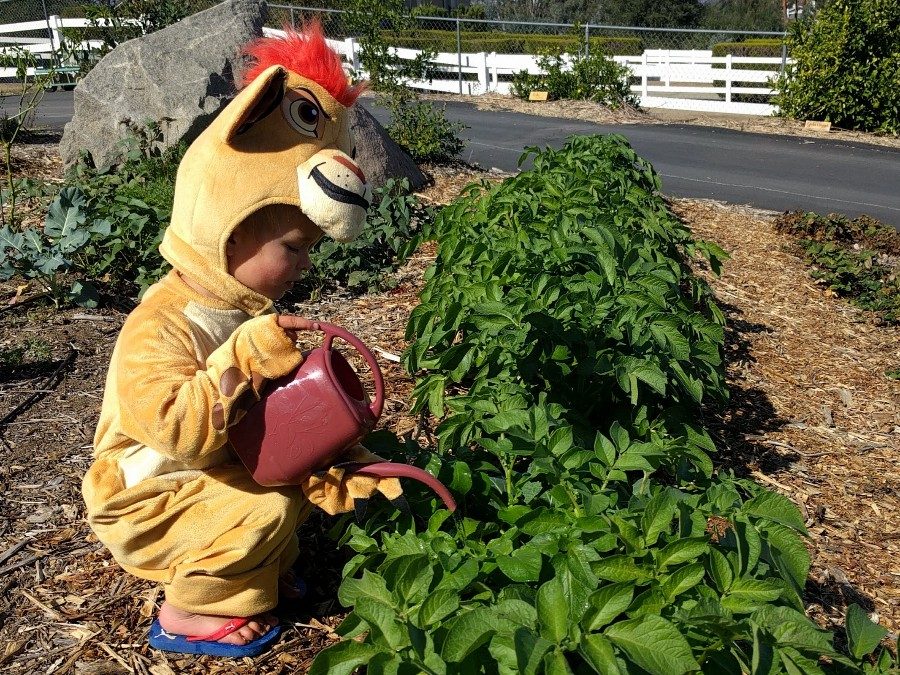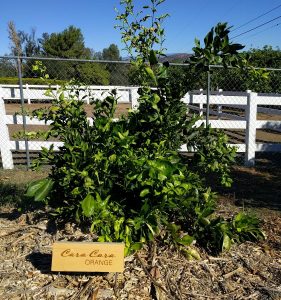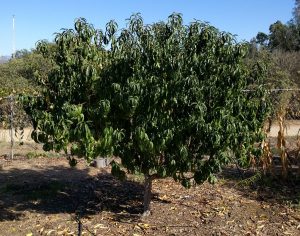It is the middle of fall and we’re running downhill right now. Can’t you feel it? Dusk already descends before dinner time. Sweatshirts are desired in the morning. And you can comfortably water potatoes in the afternoon in a Kion costume. (Halloween never ends when you’re two years old!)
It may seem that summer just ended, but actually we’re only six weeks from the shortest day of the year and the official start to winter.
Plants definitely feel it. This is what fall is for them: a transitional time between summer and winter when they grow slower and slower. Every successive day there is less light for them to eat. Our Brussels sprouts plants are rapidly enlarging their leaves here on November 2, but by Christmas the pace will have noticeably slowed.
Due to less and less light — and cooler and cooler temperatures — plants use progressively less water in the fall compared to summer. So, in fall, we should water our plants less.
Evapotranspiration in fall compared to summer
Here’s my favorite way to see how much less water plants are using in the fall compared to summer: compare evapotranspiration rates. What’s evapotranspiration (ET)? It’s essentially a measurement of how much water plants use.
As you would guess, the month with the highest ET throughout Southern California is July. In other words, plants use more water in July than in any other month, in general. Near the beach, most vegetables and fruit trees use 5 or 6 inches in July; inland it’s 6 or 7 inches.
During the fall, the ET rate inches down every day until its nadir in December, when most vegetables and fruit trees only use about 2 inches for the whole month. (This is not taking into account any rain.) So that’s a peak of 5-7 inches in summer down to only 2 inches at the tail end of fall (the last day of fall being in late December).
Another way of looking at these ET measurements is that in December most garden plants use only about 30% of what they use in summer.
Water less how?
Anyway, we all know we need to water less in November or December compared to July. The real question is how should we water less — with fewer gallons each time we water or just by watering less often? Do we change our volume or our frequency?
On average, I was watering my vegetables every three days in the summer, for 40 minutes each time (on drip emitters). Should I now water every three days for less time, say only 25 minutes? Or should I continue to water for 40 minutes, but stretch it out to only every five days?
Adjusting the frequency is better than adjusting the volume. Watering less often in the fall is preferable. It’s simply a matter of efficiency and effectiveness. When you water more often than is necessary (even if you are watering with fewer gallons each time), you are losing more water to evaporation, the water is not penetrating the soil as deeply or broadly, and you can also create persistently moist conditions that encourage diseases.
(How often to water? The best way to find out is by getting your hands dirty. Read my post about that here.)
How often to water in the fall?
In the summer, I watered my citrus trees about every four days. In October, they showed that they needed water every seven or eight days.
This past week, for example, I watered my citrus trees on October 25 and then six days later on Halloween I checked the soil of my little Cara Cara navel orange.
I grabbed some soil from around the uppermost roots, right under the mulch, and found that there was still a day or two of soil moisture left. So there at the end of October, around once a week is how often my citrus trees needed an irrigation, which is already almost twice as infrequent compared to summer.
Coming up in November, I predict waterings will decrease to every 10-13 days, and in December it will get down to every 14-16 days. This simply follows the decline in evapotranspiration.
Adjust how often . . . how often?
If our plants are using progressively less water from summer to winter, how should we lessen our frequency of watering? It’s straightforward if we’re watering by hand because we can check the soil and water as needed. I do some of that, as with the Cara Cara orange tree. But if you’ve got many plants, not much time, and an automated irrigation system, then realistically how often should the frequency be adjusted?
My vegetables are on an automatic valve, and I end up adjusting their frequency in the fall each month. I just adjusted their schedule for November to be every five days for 40 minutes. Likewise, I reset my avocados to be watered every nine days.
If adjusting monthly seems too involved, you could adjust the frequency seasonally. For example, change it in October from a summer frequency to a lesser fall frequency. Then in December sometime you’ll probably want to make another change for the winter.
In December sometime, automated systems can likely just be turned off for the winter. Usually in December we’ll have collected our first couple inches of rain and our garden plants can then magically go so much longer between irrigations, even longer than the evapotranspiration rate suggests. My personal rule of thumb is three inches: once our first three inches of rain has fallen, timers go off. At that point, the soil is saturated at least a foot deep everywhere and you can hear plants sigh relief.
What if I don’t water less often in fall?
Is there any harm in not stepping down the watering frequency through fall? What if you just keep watering on the same schedule (amount and frequency) as in summer?
Likely, if your watering was appropriate in summer and you didn’t change anything through the fall, nothing significant would go wrong. However, you would be wasting some water, which means money, and if you fertilize you’d be wasting some of that through the leaching effect of the excessive watering. And then it’s possible that diseases which like constant moisture might appear, such as root rot and crown rot on trees, or damping off of vegetable seedlings.
It may be that you get away with the overwatering; all the same, there’s nothing beneficial to it.
A special note on deciduous fruit trees
Here in November, we’ll likely need to water our peaches, plums, apples, and other deciduous fruit trees for the last time until spring. They’ll soon start losing leaves and not require more moisture in the soil than our typical rains provide. Unless the rains don’t arrive!
Last year, 2017, was the only time I’ve ever watered a deciduous fruit tree in December — it was one of the driest starts to our “rainy” season in history, not raining a single time through the fall and even early winter. That was an anomaly, and hopefully we get back to normal this year.
But what it does speak to is the fact that no matter the season, plants still use water according to the actual environmental conditions they’re experiencing — not according to historical evapotranspiration rates. It can be in the 60s and rainy in our autumn, or it can be in the 80s with Santa Ana winds. Got to keep attuned.
You might also like to read my posts:








Food for thought. I,ll see how everybody is doing and then record my watering for the next couple months so I dont waste water.
Thanks Greg
Great information. Since I tend to overwater I hope I can come up with a system to save water and money.
Loved your youngster’s potato watering picture and it brought this questions: Where do you buy your potato seedlings? And, are such seedlings available at this time of year?
Jock
Hi Jock,
Thanks. Those particular potato plants were grown from a bag of small, organic, red potatoes bought at the grocery store.
Sometimes I also buy certified seed potatoes. My local nursery has some right now. I don’t think I’ve ever actually bought potato plant seedlings from the nursery, although I’ve seen them, so I’m unsure how they do comparatively.
If you’re close to the beach (and you are if I remember correctly), then you can still plant potatoes now. Otherwise, I’d wait until February. Even when I lived closer to the beach, my best potato crops always came from February plantings.
I wrote a post about growing potatoes that you might enjoy: https://gregalder.com/yardposts/growing-potatoes-in-southern-california/